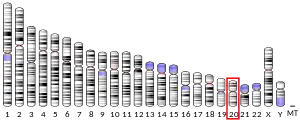| TP53RK | |||||||||||||||||||||||||||||||||||||||||||||||||||
|---|---|---|---|---|---|---|---|---|---|---|---|---|---|---|---|---|---|---|---|---|---|---|---|---|---|---|---|---|---|---|---|---|---|---|---|---|---|---|---|---|---|---|---|---|---|---|---|---|---|---|---|
| Identifiers | |||||||||||||||||||||||||||||||||||||||||||||||||||
| Aliases | TP53RK, BUD32, C20orf64, Nori-2, Nori-2p, PRPK, dJ101A2, TP53 regulating kinase, GAMOS4, TPRKB | ||||||||||||||||||||||||||||||||||||||||||||||||||
| External IDs | OMIM: 608679 MGI: 1914050 HomoloGene: 6042 GeneCards: TP53RK | ||||||||||||||||||||||||||||||||||||||||||||||||||
| EC number | 3.6.-.- | ||||||||||||||||||||||||||||||||||||||||||||||||||
| |||||||||||||||||||||||||||||||||||||||||||||||||||
| |||||||||||||||||||||||||||||||||||||||||||||||||||
| |||||||||||||||||||||||||||||||||||||||||||||||||||
| |||||||||||||||||||||||||||||||||||||||||||||||||||
| |||||||||||||||||||||||||||||||||||||||||||||||||||
| Wikidata | |||||||||||||||||||||||||||||||||||||||||||||||||||
| |||||||||||||||||||||||||||||||||||||||||||||||||||
TP53-regulating kinase, also known as PRPK is an enzyme that in humans is encoded by the TP53RK gene.[5][6][7] This protein is a serine/threonine protein kinase that phosphorylates p53 at Ser15.
PRPK is part of the KEOPS/EKC complex, which participates in transcription control,[8] telomere regulation [9] and tRNA modification.[10]
References
- 1 2 3 GRCh38: Ensembl release 89: ENSG00000172315 - Ensembl, May 2017
- 1 2 3 GRCm38: Ensembl release 89: ENSMUSG00000042854 - Ensembl, May 2017
- ↑ "Human PubMed Reference:". National Center for Biotechnology Information, U.S. National Library of Medicine.
- ↑ "Mouse PubMed Reference:". National Center for Biotechnology Information, U.S. National Library of Medicine.
- ↑ Abe Y, Matsumoto S, Wei S, Nezu K, Miyoshi A, Kito K, Ueda N, Shigemoto K, Hitsumoto Y, Nikawa J, Enomoto Y (Nov 2001). "Cloning and characterization of a p53-related protein kinase expressed in interleukin-2-activated cytotoxic T-cells, epithelial tumor cell lines, and the testes". The Journal of Biological Chemistry. 276 (47): 44003–11. doi:10.1074/jbc.M105669200. PMID 11546806.
- ↑ Facchin S, Lopreiato R, Ruzzene M, Marin O, Sartori G, Götz C, Montenarh M, Carignani G, Pinna LA (Aug 2003). "Functional homology between yeast piD261/Bud32 and human PRPK: both phosphorylate p53 and PRPK partially complements piD261/Bud32 deficiency". FEBS Letters. 549 (1–3): 63–6. doi:10.1016/S0014-5793(03)00770-1. PMID 12914926. S2CID 24581860.
- ↑ "Entrez Gene: TP53RK TP53 regulating kinase".
- ↑ Kisseleva-Romanova E, Lopreiato R, Baudin-Baillieu A, Rousselle JC, Ilan L, Hofmann K, Namane A, Mann C, Libri D (Aug 2006). "Yeast homolog of a cancer-testis antigen defines a new transcription complex". The EMBO Journal. 25 (15): 3576–85. doi:10.1038/sj.emboj.7601235. PMC 1538566. PMID 16874308.
- ↑ Downey M, Houlsworth R, Maringele L, Rollie A, Brehme M, Galicia S, Guillard S, Partington M, Zubko MK, Krogan NJ, Emili A, Greenblatt JF, Harrington L, Lydall D, Durocher D (Mar 2006). "A genome-wide screen identifies the evolutionarily conserved KEOPS complex as a telomere regulator". Cell. 124 (6): 1155–68. doi:10.1016/j.cell.2005.12.044. PMID 16564010. S2CID 13928061.
- ↑ Srinivasan M, Mehta P, Yu Y, Prugar E, Koonin EV, Karzai AW, Sternglanz R (Mar 2011). "The highly conserved KEOPS/EKC complex is essential for a universal tRNA modification, t6A". The EMBO Journal. 30 (5): 873–81. doi:10.1038/emboj.2010.343. PMC 3049205. PMID 21183954.
Further reading
- Bonaldo MF, Lennon G, Soares MB (Sep 1996). "Normalization and subtraction: two approaches to facilitate gene discovery". Genome Research. 6 (9): 791–806. doi:10.1101/gr.6.9.791. PMID 8889548.
- Miyoshi A, Kito K, Aramoto T, Abe Y, Kobayashi N, Ueda N (Apr 2003). "Identification of CGI-121, a novel PRPK (p53-related protein kinase)-binding protein". Biochemical and Biophysical Research Communications. 303 (2): 399–405. doi:10.1016/S0006-291X(03)00333-4. PMID 12659830.
- Wang SC, Lien HC, Xia W, Chen IF, Lo HW, Wang Z, Ali-Seyed M, Lee DF, Bartholomeusz G, Ou-Yang F, Giri DK, Hung MC (Sep 2004). "Binding at and transactivation of the COX-2 promoter by nuclear tyrosine kinase receptor ErbB-2". Cancer Cell. 6 (3): 251–61. doi:10.1016/j.ccr.2004.07.012. PMID 15380516.
- Abe Y, Takeuchi T, Imai Y, Murase R, Kamei Y, Fujibuchi T, Matsumoto S, Ueda N, Ogasawara M, Shigemoto K, Kito K (May 2006). "A Small Ras-like protein Ray/Rab1c modulates the p53-regulating activity of PRPK". Biochemical and Biophysical Research Communications. 344 (1): 377–85. doi:10.1016/j.bbrc.2006.03.071. PMID 16600182.
This article is issued from Wikipedia. The text is licensed under Creative Commons - Attribution - Sharealike. Additional terms may apply for the media files.



